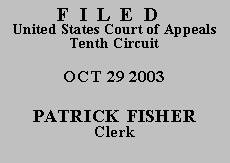

| UNITED STATES OF AMERICA, | No. 02-4218
(D.C. No. 2:02-CR-141-ST) (D. Utah) |
Discussion
Appellant concedes that he did not file any objections to the drug quantity determination in the presentence report. (Aplt. Br. at 2.) Where counsel fails to object before the sentencing court, we review the application of the sentencing guidelines for plain error. United States v. Easter, 981 F.2d 1549, 1555 (10th Cir. 1992). Plain error review, however, is not appropriate when the alleged error is one contained in the lower court's findings of fact, so that Appellant's failure to object before the district court constitutes a waiver of that issue on appeal. Id. at 1556.
Appellant styles his appeal as challenging the district court's application of the wrong guideline provision in calculating the marijuana equivalency to determine the appropriate base offense level. Even a cursory examination of his argument, however, quickly reveals that Appellant's argument is fundamentally one disputing the district court's conclusions of fact regarding the amount of drugs involved in Appellant's crime. The presentence report accepted by the district court clearly stated that the total amount of pure methamphetamine involved in Appellant's conviction was 355.71 grams. Appellant now claims that this total drug amount was not sufficiently supported by the record before the district court. This is a challenge to the district court's findings of fact, and Guzman's failure to raise it below has waived the issue on appeal.(1) Appellant also argues that the district court should have used the Guidelines' alternative marijuana equivalency formula for methamphetamine mixtures of unknown purity. However, since this argument rests entirely on his assertion that the pure drug total was unsupported, our conclusion that he has waived a challenge to the district court's findings on the pure drug amounts necessarily defeats this argument as well.(2)
Accordingly we AFFIRM the sentence and judgment of the district court.
ENTERED FOR THE COURT
David M. Ebel
Circuit Judge
*.After examining appellant's brief and the appellate record, this panel has determined unanimously that oral argument would not materially assist the determination of this appeal. See Fed. R. App. P. 34(a)(2) and 10th Cir. R. 34.1(G). The case is therefore ordered submitted without oral argument. This Order and Judgment is not binding precedent, except under the doctrines of law of the case, res judicata, and collateral estoppel. The court generally disfavors the citation of orders and judgments; nevertheless, an order and judgment may be cited under the terms and conditions of 10th Cir. R. 36.3.
1.Although Appellant's waiver prevents us from reaching the merits of his claim, we note that there is in fact ample record evidence to support the sentencing court's figure of 355.71 grams of pure methamphetamine. Appellant argues that the failure of the government to identify the specific purities of the methamphetamine mixtures involved in each count to which he pled guilty makes it impossible to calculate the total amount of pure methamphetamine involved. As Appellant himself observes, however, when evaluating the quantity of drugs for which a defendant may be held accountable, estimates are acceptable, as long as the estimate is supported by facts. United States v. Richards, 27 F.3d 465, 469 (10th Cir. 1994). Here it is undisputed that the purities of four of the five methamphetamine mixtures sold by Appellant varied from 61 to 66 percent, while the smaller fifth package weighing 34 grams was 94% pure. Calculating the total amount of pure methamphetamine using a conservative 61% for all four larger transactions yields a total of 355.23 grams. The district court's figure of 355.71 grams is clearly supported by the record.
2.There does appear to be an error in the lower court's application of the marijuana equivalency conversion tables, but it is not the error Appellant imagines. According to the equivalency tables in U.S.S.G. § 2D1.1, one gram of pure methamphetamine converts to 20 kg of marijuana. The presentencing report appears to have used a conversion factor of 1 gram = 10 kg. Since the Guidelines classify an offense involving between 3,000 kg and 10,000 kg of marijuana as a level 34 offense, however, using the 20 kg conversion factor to arrive at a total marijuana equivalency of 7,287.54 kilograms would not alter Appellant's base offense level, and we do not reach this issue because the government did not appeal this issue.